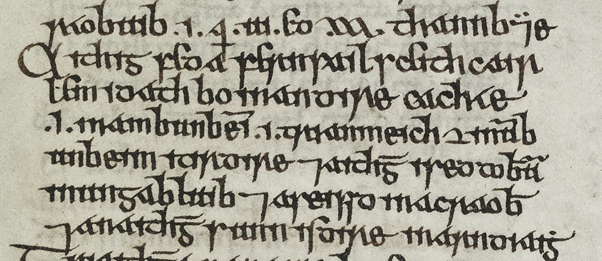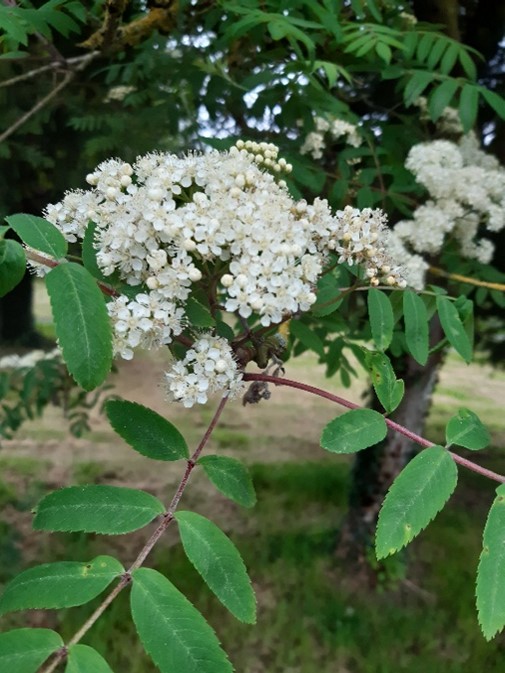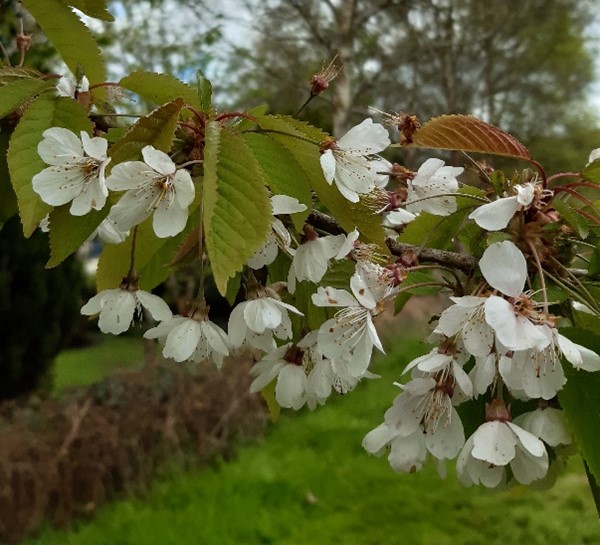Siobhán Barrett
Last March, the LEIGHEAS project published the first instalment in a two-part blog by Dr Siobhán Barrett on the medicinal uses of various trees in Irish tradition. This month, Dr Barrett revisits this theme with a discussion of the trees referred to in the Old Irish Tree List as Aithig Fedo, ‘Commoners of the Wood’.
AITHIG ḞEDO, COMMONERS OF THE WOOD
The commoners of the wood are: fern, alder; sail, willow; scé, whitethorn; cáerthann, rowan; beithe, birch; lem, elm; and idath, wild cherry.

Dublin, Trinity College MS 1336, col. 309: the second paragraph of one of the copies of the Old Irish Tree List, containing the names of the trees in the second category (image courtesy of Irish Script on Screen)
1) FERN, ALDER (eDIL s.v. 1 fern)
Irish texts include references to shields, masts and tent-poles made from alder wood (Kelly 2000, 384). The medical remedy collection in Dublin, Royal Irish Academy MS 24 B 3 contains at least 15 remedies which use parts of the alder tree as an ingredient. These include hair dye, a lotion to wash the head, a cure for head wounds, a treatment for an eye disease (possibly cataract), lung disease, stone, intestinal worms and dropsy. The majority of these remedies call for the bark of the alder and in this case the bark of the root is used:

Ar find. Mecon maeth ferna beci ⁊ snamtur a rūsc de ⁊ bid re gréin ⁊ berbtur ar englas ⁊ zītōilter a n-adarc ⁊ fagairt de fon sūil. (Dublin, RIA MS 24 B 3, p. 49.9–11; image courtesy of Irish Script on Screen)
For cataract. Soft root of a small alder and peel the bark from it and let it be it in the sun (to dry) and it is boiled in whey and it is strained (?) into a cupping horn and a salve of it is put on the eye.
2) SAIL, WILLOW (eDIL s.v. sail)
There are several species of willow which are native to Ireland. Pliable willow shoots were used to make withes and there are references to animals being restrained by twisted willow withes. It was also used as a building material (Kelly 2000, 384). Harps were made from willow and the most famous Irish harp of all, Brian Boru’s Harp (which actually dates from the 14th century) is made entirely from willow (Mac Coitir 2015, 43). Willow was and is still used for basket-making and although there are references in many texts to baskets (see eDIL s.v. 2 ces), I have not found a specific reference to a willow basket. Numerous occurrences of ingredients derived from willow parts are found in the aforementioned medical text, including the flowers, the leaves, bark, inner bark and the ashes of willow, which are used for a variety of ailments including headaches, eye diseases, cancer and dropsy. Willow bark contains salicylic acid (named from Latin salix, willow tree); this compound was one of the starting materials used in the production of acetylsalicylic acid or aspirin. The reference to a King of Dál nAraidi in this recipe for an eye salve may refer to the seventh-century ruler Congal Cáech, who is said to have lost the kingship of Tara because he was maimed after receiving a bee sting to the eye (see Barrett 2019):

Fobairt rīg Dāl nAraidi .i. edursnam glas uindsend ⁊ soilech, brister ⁊ fāscther tre brét ⁊ curtur mil tana air ⁊ salann ⁊ do berar fiuchad ⁊ curtur fon sūil ⁊ īccaid. (Dublin, RIA MS 24 B 3, p. 52.4–6; image courtesy of Irish Script on Screen)
The king of Dál nAraidi’s salve, .i.e. green inner bark of ash and willow are broken and strained through a cloth, and thin honey is put on it and salt; it is brought to the boil and is put on the eye and it heals.
3) SCÉ, WHITETHORN (eDIL s.v. scé)
In folklore, the whitethorn is associated with the supernatural world (see Mac Coitir 2015, 52–7) but I have not found this tradition reflected in the medical texts. There are a few instances of whitethorn being used as a medical ingredient: it is used as a cure for liver disease; the flowers are used in a remedy for a head wound; the bark is boiled in milk as a cure for a rapid heartbeat; and the leaves are used in this remedy below for testicular hernia:

Ar at uirged re n-abur tumaig magrall .i. duillebar scīach do chocnam ⁊ gelán uige trīt ⁊ a sūathad ⁊ a cur ar scrait līn im na huirgib, ⁊ fuil do lēgen a haigtib a lurgan ⁊ snāiti do cur tarsna fuithib ar in letar tana ⁊ slánaigidh sin an tumaigi, ⁊ mad i sēin raib ann, as héicen ligen uirre, ⁊ mina raib lind a fogus inti, curtur losa guir uirre. (Dublin, RIA MS 23 N 29, fol. 9r20–5; image courtesy of Irish Script on Screen)
For a swelling of the testicles that is called tumaigh maghrall (‘hernia of the testicles’), i.e. chew the leafage of a whitethorn and [stir] the white of an egg through it and mix them and put it on a linen rag around the testicles and let blood from the surfaces of his shins, and put a thread across the base [of the testicles] on the thin skin and that heals the hernia, and if [the hernia] is there, it is necessary to release it, and if liquid is not near it, herbs [to treat] inflammation are to be put on it. (see Hayden 2021, 267)
4) CÁERTHANN, ROWAN (eDIL s.v. cáerthann)

Kelly (2000) says that there is little information about the uses of rowan apart from its use as a spit to roast meat. However the beauty of the flowers and the berries of rowan tree are frequently referred to in literature. Medical texts have descriptions of magical words being written on wands made of rowan wood for ‘love charms’ (see Hayden forthcoming). Rowan bark is found as an ingredient in cures for cancer, epilepsy, diarrhoea, haemorroids and asthma, as illustrated by this remedy:

Cosc ar mūchad ⁊ ar lir .i. crotoll fraich ⁊ crotoll cuilind ⁊ caerthaind ⁊ a rusc ⁊ eipericum beaain ⁊ gleōrān ⁊ berbtur ar chuirm nó ar lemnacht ⁊ ebar fōs ar cétlongad. (Dublin, RIA MS 24 B 3, p. 62.15–17; image courtesy of Irish Script on Screen)
A cure for asthma and diarrhoea. Bark of heather and bark of holly and rowan and its bark and St John’s wort and gleōrān (cuckoo flower?) and it is boiled in beer or in milk and it is also drunk fasting.
5) BEITHE, BIRCH (eDIL s.v. beithe)
Birch is a common native tree. In spite of that, there are not many instances of birch in texts, but one legend tells us that St Patrick threw a handbell under a bush and a birch tree grew through its handle (Stokes 1887, 249). As a medical ingredient, it is found in remedies to treat eye diseases, dropsy and erysipelas, as in the following cure:

Ar temel .i. duille fēthe ⁊ rusc soilech ⁊ rusc bethe, a sug do cur a n-adairc ⁊ a cur fon sūil. (RIA 24 B 3, p. 49.20–21; image courtesy of Irish Script on Screen)
For blindness. Leaves of bindweed and willow bark and birch bark. Their sap is put in a cupping horn and it is applied to the eye.
6) LEM, ELM (eDIL s.v. 1 lem)
Wych elm is the native Irish elm variety. Elm wood was valued for its water-resistant qualities, making it useful in boat-building. Elm trees are endangered worldwide now because of Dutch elm disease, which is spread by beetles carrying fungal spores. There are suggestions in texts that elm-branches were used as cattle fodder and that ropes or thongs were made from elm-bark (Kelly 2000, 42). Ingredients derived from elm are used in remedies for urinary stone, in an ointment for head wounds, in a poultice for headache, to treat dropsy and heart disease. In the charm to cure impotence below, it is being recommended for its magical curative effect rather than its medicinal value:

Ar in cétna .i. ainm an fir do scrībad tre ogam a crand lemāin ⁊ in fer do būalad de. (RIA 23 N 29, 9r10–11; image courtesy of Irish Script on Screen)
For the same (impotence), i.e. write the name of the man in Ogam on a stick of elm and beat/strike the man with it. (see Hayden 2021, 266)
7) IDATH, WILD CHERRY (eDIL s.v. idath)

The wild cherry is a particularly beautiful tree with pale pink or white flowers in spingtime, followed by the edible cherries. There is a ninth-century Irish poem, in the form of a dialogue between a king and a hermit, in which the beauty of the hermit’s home, a hut in the woods, is described to the king. The abundance of nuts and fruits, including cherries, is mentioned as one of the many attractions of living in the woods (Murphy 1998, 13).
Although there are not many remedies which use the cherry tree, it is found in remedies for lung disease, epilepsy, dropsy and in the remedy below for a poultice, made from flowers of many trees, that is used to treat a head/brain injury that occurs in the summertime. I am uncertain of some aspects of this translation.

Cosc frisin n-incinn cūil mad a samrad bēs .i. bláth droigin ⁊ soilech ⁊ scīach ⁊ blāt[h] ferdrisi ⁊ bláth smér ⁊ bláth caortuind ⁊ findcuill fida[i]d. Minaicter gu min gu mbid [i]na taos ⁊ do berur ⁊ do berbtar ar ūactar sug mecon lim ⁊ bande ⁊ mil da fagba ⁊ mena fadba curtur as caerach nó gabar air ⁊ doniter cerīn díb ⁊ do berar [i]mon cend mad cnoc nó fuilligain ⁊ mad crechd indrach de ind. (Dublin, RIA MS 24 B 3, p. 45.26, 25 and 27–30; image courtesy of Irish Script on Screen)
A cure for (an injury to) the back (of the) brain, if it is summer, flowers of blackthorn and willow and whitethorn and flowers of wildrose and flowers of blackberry and flowers of rowan and whitebeam, cherry. Shred finely until it is a pulp and add it and boil with cream, sap of elm root, and milk and honey if available; if not, add sheep’s or goat’s milk and make a poultice from them and place it on the head if it is a lump or a wound, and if it is an ulcer a tent of it (is placed) there.
Further reading
- Barrett, Siobhán (2019) ‘The King of Dál nAraidi’s Salve’ Ériu 69: 171–8
- Hayden, Deborah (2021) ‘A Sixteenth-Century Irish Collection of Remedies for Ailments of the Male Reproductive Organs’ Celtica 33: 248–76
- Hayden, Deborah (forthcoming) ‘Premodern Irish Rituals for Conception and Childbirth in their Insular Context’, in Medicine in the Medieval North Atlantic World: Vernacular Texts and Traditions, edited by Deborah Hayden and Sarah Baccianti (Turnhout: Brepols)
- Mac Coitir, Niall (2015) Ireland’s Trees: Myths, Legends and Folklore (Cork: The Collins Press)
- Murphy, Gerard, ed. (1998) Early Irish Lyrics: Eighth to Twelfth Century. (Dublin: Four Courts Press)
- Stokes, Whitley, ed. (1887) The Tripartite Life of Patrick: With Other Documents Relating to That Saint (London: H.M. Stationery Office)